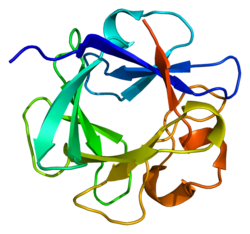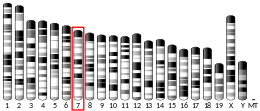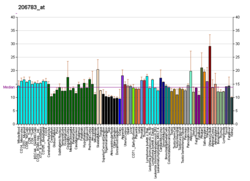FGF4
FGF4섬유아세포증식인자 4는 FGF4 [5][6]유전자에 의해 인체 내에서 암호화되는 단백질이다.
이 유전자에 의해 암호화된 단백질은 섬유아세포 성장인자(FGF) 계열의 구성원이다.FGF 패밀리는 광범위한 유사분열 및 세포 생존 활동을 가지고 있으며 배아 발달, 세포 성장, 형태 형성, 조직 복구, 종양 성장 및 침입을 포함한 다양한 생물학적 과정에 관여합니다.이 유전자는 발암 형질전환 활성에 의해 확인되었다.이 유전자와 또 다른 발암성 성장인자인 FGF3는 11번 염색체에 밀접하게 위치해 있다.두 유전자의 공증폭은 다양한 종류의 인간 종양에서 발견되었다.쥐의 상동성에 대한 연구는 소닉 헤지호그(SHH) 신호 [6]경로를 통한 뼈 형태 형성 및 사지 발달의 기능을 제시했다.
기능.
배아 발달 동안, 21-kD 단백질 FGF4는 많은 중요한 [7][8]과정에 관여하는 신호 분자로 기능합니다.Fgf4 유전자 녹아웃 마우스를 사용한 연구는 체내 및 체외 배아의 발달 결함을 보여주었고, FGF4가 자가분비 또는 파라크린 [7]배위자로 작용함으로써 이식 후 발달 단계 동안 내부 세포 질량의 생존과 성장을 촉진한다는 것을 밝혀냈다.정점외배엽능(AER)에서 생성되는 FGF는 적절한 앞다리 및 뒷다리 발육에 [9]매우 중요하다.AER의 FGF 시그널링은 지간 [10]간엽의 사지 자리수 및 세포사 조절에 관여한다.FGF 시그널링 역학 및 조절 과정이 변경되면, 후축 다축성 및 피부 신디악티리, 총칭하여 다축성이라고 알려진 두 가지 표현형 이상이 사지에 발생할 수 있습니다.야생형 생쥐의 사지 싹에서 Fgf4의 과잉이 발현될 때 다신작용이 관찰된다.Fgf8을 발현하지 않는 돌연변이 사지 봉오리에서 Fgf4의 발현은 여전히 다신작용을 일으키지만 Fgf4는 또한 Fgf8의 부족으로 인해 발생하는 모든 골격 결함을 구제할 수 있다.따라서 Fgf4 유전자는 Fgf8 유전자의 손실을 보상하고, FGF4와 FGF8이 사지 골격 패턴 형성 및 [10]사지 발달에서 유사한 기능을 수행함을 보여준다.제브라피쉬 Fgf4 녹다운 배아의 연구는 Fgf4 신호가 억제되면 간, 췌장, 심장의 무작위 좌우 패턴화가 일어난다는 것을 보여주며, Fgf4가 내장 기관의 좌우 패턴 생성에 관여하는 중요한 유전자임을 보여주었다.또한 사지발달에 있어서 FGF4의 역할과는 달리 FGF4와 FGF8은 내장기관의 좌우패터닝 [11]과정에서 독립된 역할과 기능을 가진다.Fgf 시그널링 경로는 위장 발달 중에 힌지 정체성을 유도하는 것으로 입증되었으며,[12] 만능 줄기세포에서 Fgf4의 상향 조절은 장내 유기체 및 체외 조직의 생성을 위한 분화를 유도하기 위해 사용되었다.
FGF4 레트로제인
송곳니에서 염색체 18에 대한 FGF4 레트로겐 삽입은 짧은 다리 표현형에 [13]관여한다.이것은 여전히 FGF4 유전자 패밀리의 일원입니다.섬유아세포 성장인자 4는 단백질 코드 유전자입니다. 구조 단백질 [14]분자라는 뜻입니다.FGF4-18이 수행하는 생물학적 역할은 배아 발달, 특히 적절한 성장에 중요하다.송곳니에서 이 레트로겐 돌연변이 패턴화가 초래하는 발달구조는 연골내 골화의 결함으로 인해 다리가 짧아졌다.이러한 돌연변이와 FGF 시그널링 이상은 [13][15]뼈가 정상 길이로 자라지 못하게 함으로써 왜소증과도 관련이 있다.이 FGF4 레트로겐은 18번 염색체뿐만 아니라 12번 염색체에서도 추간판 질환과 관련된 팔다리의 단축과 척추의 이상을 일으킨다.캘리포니아 데이비스 대학에서 수행된 연구는 또한 12번 염색체에 대한 FGF4 레트로겐이 짧은 다리와 비정상적인 추간판 때문에 [13]퇴화된다는 것을 발견했다.송곳니에 있는 이 특별한 FGF4-12 레트로겐은 IVDD(추간판 질환)[13][15]에 걸리기 쉬운 이형성 감소, 조기 퇴화 및 추간판의 석회화로 인해 짧은 사지 표현형을 초래한다.
레퍼런스
- ^ a b c GRCh38: 앙상블 릴리즈 89: ENSG000075388 - 앙상블, 2017년 5월
- ^ a b c GRCm38: 앙상블 릴리즈 89: ENSMUSG000050917 - 앙상블, 2017년 5월
- ^ "Human PubMed Reference:". National Center for Biotechnology Information, U.S. National Library of Medicine.
- ^ "Mouse PubMed Reference:". National Center for Biotechnology Information, U.S. National Library of Medicine.
- ^ Galland F, Stefanova M, Lafage M, Birnbaum D (Jul 1992). "Localization of the 5' end of the MCF2 oncogene to human chromosome 15q15----q23". Cytogenetics and Cell Genetics. 60 (2): 114–6. doi:10.1159/000133316. PMID 1611909.
- ^ a b "Entrez Gene: FGF4 fibroblast growth factor 4 (heparin secretory transforming protein 1, Kaposi sarcoma oncogene)".
- ^ a b Feldman B, Poueymirou W, Papaioannou VE, DeChiara TM, Goldfarb M (Jan 1995). "Requirement of FGF-4 for postimplantation mouse development". Science. 267 (5195): 246–9. Bibcode:1995Sci...267..246F. doi:10.1126/science.7809630. PMID 7809630. S2CID 31312392.
- ^ Yuan H, Corbi N, Basilico C, Dailey L (Nov 1995). "Developmental-specific activity of the FGF-4 enhancer requires the synergistic action of Sox2 and Oct-3". Genes & Development. 9 (21): 2635–45. doi:10.1101/gad.9.21.2635. PMID 7590241.
- ^ Boulet AM, Moon AM, Arenkiel BR, Capecchi MR (Sep 2004). "The roles of Fgf4 and Fgf8 in limb bud initiation and outgrowth". Developmental Biology. 273 (2): 361–72. doi:10.1016/j.ydbio.2004.06.012. PMID 15328019.
- ^ a b Lu P, Minowada G, Martin GR (Jan 2006). "Increasing Fgf4 expression in the mouse limb bud causes polysyndactyly and rescues the skeletal defects that result from loss of Fgf8 function". Development. 133 (1): 33–42. doi:10.1242/dev.02172. PMID 16308330.
- ^ Yamauchi H, Miyakawa N, Miyake A, Itoh N (Aug 2009). "Fgf4 is required for left-right patterning of visceral organs in zebrafish". Developmental Biology. 332 (1): 177–85. doi:10.1016/j.ydbio.2009.05.568. PMID 19481538.
- ^ Lancaster MA, Knoblich JA (2014). "Organogenesis in a dish: modeling development and disease using organoid technologies". Science. 345 (6194): 1247125. doi:10.1126/science.1247125. PMID 25035496. S2CID 16105729.
- ^ a b c d "Genetic Discovery Finds Dachshunds' Short-Leg Phenotype Linked To IVDD". www.purinaproclub.com. Retrieved 2022-04-13.
- ^ "FGFR3 Gene - GeneCards FGFR3 Protein FGFR3 Antibody". www.genecards.org. Retrieved 2022-04-13.
- ^ a b Brown, Emily A.; Dickinson, Peter J.; Mansour, Tamer; Sturges, Beverly K.; Aguilar, Miriam; Young, Amy E.; Korff, Courtney; Lind, Jenna; Ettinger, Cassandra L.; Varon, Samuel; Pollard, Rachel (2017-10-24). "FGF4 retrogene on CFA12 is responsible for chondrodystrophy and intervertebral disc disease in dogs". Proceedings of the National Academy of Sciences. 114 (43): 11476–11481. doi:10.1073/pnas.1709082114. ISSN 0027-8424. PMC 5664524. PMID 29073074.
추가 정보
- Powers CJ, McLeskey SW, Wellstein A (Sep 2000). "Fibroblast growth factors, their receptors and signaling". Endocrine-Related Cancer. 7 (3): 165–97. CiteSeerX 10.1.1.323.4337. doi:10.1677/erc.0.0070165. PMID 11021964.
- Taira M, Yoshida T, Miyagawa K, Sakamoto H, Terada M, Sugimura T (May 1987). "cDNA sequence of human transforming gene hst and identification of the coding sequence required for transforming activity". Proceedings of the National Academy of Sciences of the United States of America. 84 (9): 2980–4. Bibcode:1987PNAS...84.2980T. doi:10.1073/pnas.84.9.2980. PMC 304784. PMID 2953031.
- Delli Bovi P, Curatola AM, Kern FG, Greco A, Ittmann M, Basilico C (Aug 1987). "An oncogene isolated by transfection of Kaposi's sarcoma DNA encodes a growth factor that is a member of the FGF family". Cell. 50 (5): 729–37. doi:10.1016/0092-8674(87)90331-X. PMID 2957062. S2CID 30018932.
- Yoshida T, Miyagawa K, Odagiri H, Sakamoto H, Little PF, Terada M, Sugimura T (Oct 1987). "Genomic sequence of hst, a transforming gene encoding a protein homologous to fibroblast growth factors and the int-2-encoded protein". Proceedings of the National Academy of Sciences of the United States of America. 84 (20): 7305–9. Bibcode:1987PNAS...84.7305Y. doi:10.1073/pnas.84.20.7305. PMC 299281. PMID 2959959.
- Wada A, Sakamoto H, Katoh O, Yoshida T, Yokota J, Little PF, Sugimura T, Terada M (Dec 1988). "Two homologous oncogenes, HST1 and INT2, are closely located in human genome". Biochemical and Biophysical Research Communications. 157 (2): 828–35. doi:10.1016/S0006-291X(88)80324-3. PMID 2974287.
- Huebner K, Ferrari AC, Delli Bovi P, Croce CM, Basilico C (1989). "The FGF-related oncogene, K-FGF, maps to human chromosome region 11q13, possibly near int-2". Oncogene Research. 3 (3): 263–70. PMID 3060803.
- Adelaide J, Mattei MG, Marics I, Raybaud F, Planche J, De Lapeyriere O, Birnbaum D (Apr 1988). "Chromosomal localization of the hst oncogene and its co-amplification with the int.2 oncogene in a human melanoma". Oncogene. 2 (4): 413–6. PMID 3283658.
- Ornitz DM, Xu J, Colvin JS, McEwen DG, MacArthur CA, Coulier F, Gao G, Goldfarb M (Jun 1996). "Receptor specificity of the fibroblast growth factor family". The Journal of Biological Chemistry. 271 (25): 15292–7. doi:10.1074/jbc.271.25.15292. PMID 8663044.
- Tanaka S; et al. (1998). "Promotion of trophoblast stem cell proliferation by FGF-4". Science. 282 (5396): 2072–2075. Bibcode:1998Sci...282.2072T. doi:10.1126/science.282.5396.2072. PMID 9851926.
- Helland R, Berglund GI, Otlewski J, Apostoluk W, Andersen OA, Willassen NP, Smalås AO (Jan 1999). "High-resolution structures of three new trypsin-squash-inhibitor complexes: a detailed comparison with other trypsins and their complexes". Acta Crystallographica Section D. 55 (Pt 1): 139–48. doi:10.1107/S090744499801052X. PMID 10089404.
- Bellosta P, Iwahori A, Plotnikov AN, Eliseenkova AV, Basilico C, Mohammadi M (Sep 2001). "Identification of receptor and heparin binding sites in fibroblast growth factor 4 by structure-based mutagenesis". Molecular and Cellular Biology. 21 (17): 5946–57. doi:10.1128/MCB.21.17.5946-5957.2001. PMC 87313. PMID 11486033.
- Britto JA, Evans RD, Hayward RD, Jones BM (Dec 2001). "From genotype to phenotype: the differential expression of FGF, FGFR, and TGFbeta genes characterizes human cranioskeletal development and reflects clinical presentation in FGFR syndromes". Plastic and Reconstructive Surgery. 108 (7): 2026–39, discussion 2040–6. doi:10.1097/00006534-200112000-00030. PMID 11743396.
- Yamamoto H, Ochiya T, Tamamushi S, Toriyama-Baba H, Takahama Y, Hirai K, Sasaki H, Sakamoto H, Saito I, Iwamoto T, Kakizoe T, Terada M (Jan 2002). "HST-1/FGF-4 gene activation induces spermatogenesis and prevents adriamycin-induced testicular toxicity". Oncogene. 21 (6): 899–908. doi:10.1038/sj.onc.1205135. PMID 11840335.
- Sieuwerts AM, Martens JW, Dorssers LC, Klijn JG, Foekens JA (Apr 2002). "Differential effects of fibroblast growth factors on expression of genes of the plasminogen activator and insulin-like growth factor systems by human breast fibroblasts". Thrombosis and Haemostasis. 87 (4): 674–83. doi:10.1055/s-0037-1613065. PMID 12008951.
- Koh KR, Ohta K, Nakamae H, Hino M, Yamane T, Takubo T, Tatsumi N (Oct 2002). "Differential effects of fibroblast growth factor-4, epidermal growth factor and transforming growth factor-beta1 on functional development of stromal layers in acute myeloid leukemia". Leukemia Research. 26 (10): 933–8. doi:10.1016/S0145-2126(02)00033-4. PMID 12163055.
- Lopez-Sanchez C, Climent V, Schoenwolf GC, Alvarez IS, Garcia-Martinez V (Aug 2002). "Induction of cardiogenesis by Hensen's node and fibroblast growth factors". Cell and Tissue Research. 309 (2): 237–49. doi:10.1007/s00441-002-0567-2. PMID 12172783. S2CID 11783465.
- Wang P, Branch DR, Bali M, Schultz GA, Goss PE, Jin T (Oct 2003). "The POU homeodomain protein OCT3 as a potential transcriptional activator for fibroblast growth factor-4 (FGF-4) in human breast cancer cells". The Biochemical Journal. 375 (Pt 1): 199–205. doi:10.1042/BJ20030579. PMC 1223663. PMID 12841847.
- Reményi A, Lins K, Nissen LJ, Reinbold R, Schöler HR, Wilmanns M (Aug 2003). "Crystal structure of a POU/HMG/DNA ternary complex suggests differential assembly of Oct4 and Sox2 on two enhancers". Genes & Development. 17 (16): 2048–59. doi:10.1101/gad.269303. PMC 196258. PMID 12923055.
- Hirai K, Sasaki H, Yamamoto H, Sakamoto H, Kubota Y, Kakizoe T, Terada M, Ochiya T (Mar 2004). "HST-1/FGF-4 protects male germ cells from apoptosis under heat-stress condition". Experimental Cell Research. 294 (1): 77–85. doi:10.1016/j.yexcr.2003.11.012. PMID 14980503.
- Grigor'eva EV, Shevchenko AI, Mazurok NA, Elisaphenko EA, Zhelezova AI, Shilov AG, Dyban PA, Dyban AP, Noniashvili EM, Slobodyanyuk SY, Nesterova TB, Brockdorff N, Zakian SM (2009). "FGF4 independent derivation of trophoblast stem cells from the common vole". PLOS ONE. 4 (9): e7161. Bibcode:2009PLoSO...4.7161G. doi:10.1371/journal.pone.0007161. PMC 2744875. PMID 19777059.
- Boulet AM, Capecchi MR (Nov 2012). "Signaling by FGF4 and FGF8 is required for axial elongation of the mouse embryo". Developmental Biology. 371 (2): 235–45. doi:10.1016/j.ydbio.2012.08.017. PMC 3481862. PMID 22954964.









